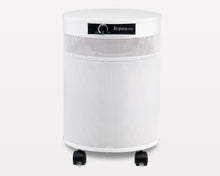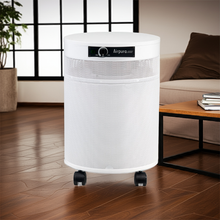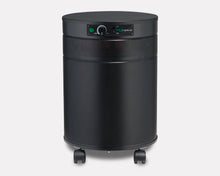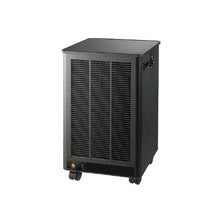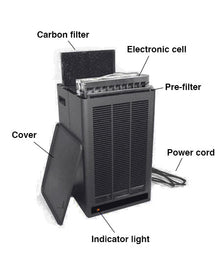Decoding Air Purifier Specifications: A Guide to CADR, ACH, and MERV Ratings for Serious Buyers

Are you tired of vague marketing claims and confusing numbers when trying to choose the right air purifier? Do you find yourself overwhelmed by acronyms like CADR, ACH, and MERV, unsure of what they truly mean for the air you breathe? At Commercial Air Purifiers, LLC, we understand this frustration. As a company dedicated to bringing the highest quality air purification solutions to the market, we believe in empowering our customers with the knowledge they need to make informed decisions. This comprehensive guide will demystify these crucial air purifier specifications, providing you with the expertise to select a unit that truly meets your needs.
The importance of indoor air quality has become increasingly clear in recent years. From allergens and dust to volatile organic compounds (VOCs) and airborne pathogens, the air within our homes and workplaces can harbor a surprising array of contaminants. Studies by the Environmental Protection Agency (EPA) have consistently shown that indoor pollutant levels can be significantly higher than outdoor levels. This is particularly concerning considering that most people spend a significant majority of their time indoors. Poor indoor air quality has been linked to a range of health issues, including respiratory problems like asthma and allergies, as well as headaches, fatigue, and even more serious long-term health effects. Investing in an effective air purifier is an investment in your health and well-being, but navigating the technical specifications is essential to making the right choice.
Understanding CADR: Clean Air Delivery Rate
One of the most commonly cited specifications for air purifiers is the Clean Air Delivery Rate, or CADR. This number, typically expressed in cubic feet per minute (CFM), indicates the volume of purified air that an air purifier can deliver at its highest fan speed. In simpler terms, it tells you how quickly an air purifier can remove specific types of pollutants from a room of a certain size.
The CADR rating is determined through standardized testing conducted by the Association of Home Appliance Manufacturers (AHAM). During these tests, the air purifier is placed in a controlled environment, and its ability to remove three common types of indoor air pollutants is measured:
-
Smoke: Representing fine particles in the air.
-
Dust: Representing larger airborne particles.
-
Pollen: Representing even larger allergen particles.
For each of these pollutants, the air purifier is assigned a separate CADR rating. When evaluating an air purifier, it's important to look at all three CADR numbers to understand its overall performance. Generally, a higher CADR number indicates a faster rate of air purification for that specific type of particle.
Why is CADR important for serious buyers?
The CADR rating provides a tangible measure of an air purifier's effectiveness in reducing airborne particles. Instead of relying on vague claims, you can use the CADR to compare the performance of different models. For instance, if you suffer from allergies, you'll want to pay close attention to the pollen and dust CADR ratings. If you're concerned about smoke from nearby wildfires or cooking, the smoke CADR will be a key factor.
As Commercial Air Purifiers, LLC, we recommend considering the size of the room you intend to use the air purifier in when evaluating CADR. AHAM suggests a "two-thirds rule," meaning that the CADR rating for a particular pollutant should be at least two-thirds of the room's square footage (assuming a standard 8-foot ceiling height). For example, for a 300-square-foot room, you would ideally look for an air purifier with a CADR of at least 200 for the pollutants you are most concerned about.
It's also important to note that CADR tests are conducted at the highest fan speed. While this provides a benchmark for comparison, you may not always run your air purifier at its maximum setting due to noise concerns. However, a higher CADR generally indicates a more powerful unit that can still provide effective purification at lower speeds.
Understanding ACH: Air Changes Per Hour
Another crucial specification to understand is Air Changes Per Hour, or ACH. This metric indicates how many times the total volume of air in a room is completely replaced with purified air in one hour. A higher ACH number means that the air in the room is being filtered more frequently, which can lead to better overall air quality.
Unlike CADR, ACH is not a standardized test result provided by manufacturers. Instead, it's a calculation based on the air purifier's airflow rate (often related to its CADR) and the size of the room. The formula for calculating ACH is:
ACH = (Airflow Rate in CFM x 60) / Room Volume in Cubic Feet
For example, if an air purifier has an airflow rate of 200 CFM and is used in a room that is 15 feet long, 10 feet wide, and 8 feet high (volume = 1200 cubic feet), the ACH would be:
ACH = (200 CFM x 60) / 1200 cubic feet = 10 ACH
This means the air in that room would be completely replaced with purified air 10 times per hour.
Why is ACH important for serious buyers?
ACH provides valuable context for understanding how effectively an air purifier can maintain good air quality over time. While CADR tells you how quickly pollutants are removed initially, ACH indicates the ongoing rate of air purification.
For individuals with severe allergies or respiratory conditions, or in environments with high levels of air pollution, a higher ACH is generally desirable. Organizations like the American Lung Association often recommend aiming for at least 4 ACH in living spaces to effectively reduce allergen and particle levels. In critical environments like hospitals or cleanrooms, even higher ACH rates are often required.
At Commercial Air Purifiers, LLC, we believe that considering both CADR and ACH is essential for selecting the right air purifier. A unit with a high CADR might quickly reduce initial pollutant levels, but a lower ACH might mean that the air quality deteriorates more quickly between purification cycles. Conversely, a unit with a moderate CADR but a high ACH can provide consistent air purification throughout the day.
Understanding MERV Rating: Minimum Efficiency Reporting Value
The final critical specification we'll explore is the Minimum Efficiency Reporting Value, or MERV rating. This rating system is used to evaluate the effectiveness of air filters in capturing airborne particles of different sizes. The MERV rating scale ranges from 1 to 20, with higher numbers indicating a greater ability to filter out smaller particles.
MERV ratings are based on a standardized test method (ANSI/ASHRAE Standard 52.2) that measures the filter's efficiency in capturing particles in three size ranges:
-
E1: Particles 0.3 to 1.0 micrometers in size (e.g., bacteria, some viruses, fine smoke particles)
-
E2: Particles 1.0 to 3.0 micrometers in size (e.g., mold spores, pet dander)
-
E3: Particles 3.0 to 10.0 micrometers in size (e.g., pollen, dust mites)
A filter with a higher MERV rating will be more efficient at capturing particles in all three size ranges.
Why is MERV rating important for serious buyers?
The MERV rating directly reflects the level of filtration provided by an air purifier. Understanding this rating is crucial for choosing a unit that can effectively address your specific air quality concerns.
-
MERV 1-4: These filters offer basic filtration, primarily capturing larger particles like dust, lint, and pet hair. They are often found in residential HVAC systems but are generally not sufficient for significant air purification.
-
MERV 5-8: These filters offer improved filtration, capturing smaller particles like mold spores and some pollen. They are a common upgrade for residential HVAC systems.
-
MERV 9-12: These filters provide significant filtration, capturing finer particles like smog, fine dust, and smaller allergens. Air purifiers with filters in this range are often suitable for individuals with moderate allergies or asthma.
-
MERV 13-16: These high-efficiency filters can capture very fine particles, including bacteria, viruses, and smoke. Air purifiers with MERV 13 or higher filters are often recommended for individuals with severe allergies, respiratory conditions, or concerns about airborne pathogens.
-
MERV 17-20: These are ultra-high-efficiency filters typically used in specialized applications like hospitals, cleanrooms, and laboratories where the highest levels of air purity are required.
At Commercial Air Purifiers, LLC, we prioritize using high-quality filters with appropriate MERV ratings in our products to ensure effective particle removal. It's important to note that while higher MERV ratings generally mean better filtration, they can also lead to increased airflow resistance, potentially reducing the air purifier's CADR and increasing energy consumption. Therefore, it's crucial to strike a balance between filtration efficiency and airflow.
Many high-performance air purifiers today utilize HEPA (High-Efficiency Particulate Air) filters. While the term HEPA is often used interchangeably with high MERV ratings, it has a specific definition. According to established standards, a true HEPA filter must be able to remove at least 99.97% of particles 0.3 micrometers in diameter. Filters with MERV ratings of 17 or higher typically meet or exceed HEPA standards.
The Interplay of CADR, ACH, and MERV
Understanding CADR, ACH, and MERV individually is important, but it's even more crucial to consider how they work together to determine an air purifier's overall effectiveness.
-
MERV rating determines what the filter can capture. A higher MERV rating means the filter can trap smaller and more numerous particles.
-
CADR indicates how quickly the air purifier can deliver filtered air. A higher CADR means faster removal of airborne particles from the room.
-
ACH reflects how frequently the entire volume of air in the room is filtered. A higher ACH ensures consistent air purification over time.
An air purifier with a high MERV filter but a low CADR might effectively capture pollutants, but it will take longer to clean the air in the room. Conversely, a unit with a high CADR but a low MERV filter will move a large volume of air quickly but may not effectively remove smaller, more harmful particles. A balanced approach, considering all three specifications in relation to your specific needs and environment, is key to making an informed decision.
Real-World Considerations and Our Experience
At Commercial Air Purifiers, LLC, our experience in designing and testing air purification systems has reinforced the importance of these specifications. We conduct rigorous internal testing, evaluating the CADR of our units across various particle sizes and ensuring our filters meet the stated MERV ratings. We also gather feedback from our customers in diverse environments, from homes with allergy sufferers to commercial spaces with specific air quality challenges.
One instance that highlights the importance of understanding these ratings involved a customer who operated a small woodworking shop. They were primarily concerned about sawdust and larger particles and initially purchased a basic air purifier with a moderate CADR but a lower MERV rating. While it did capture some of the visible dust, they noticed that finer dust particles continued to linger in the air, causing respiratory irritation over time. After understanding the role of MERV rating in capturing smaller particles, they upgraded to one of our units with a higher MERV filter, specifically designed for capturing fine dust, and experienced a significant improvement in their indoor air quality. This real-world example underscores the importance of aligning the air purifier's capabilities with the specific pollutants of concern.
Furthermore, our testing has shown that the ideal ACH for a given space can vary depending on the activities taking place within it. A bedroom might benefit from 4-6 ACH to maintain good air quality during sleep, while a busy office or a room with pets might require 6-8 ACH or even higher to effectively manage allergens and other pollutants generated throughout the day.
Solutions and Recommendations from Commercial Air Purifiers, LLC
Based on our expertise, we offer the following recommendations when evaluating air purifier specifications:
-
Identify Your Primary Concerns: Determine the main types of pollutants you want to address (e.g., allergens, smoke, VOCs, pet dander). This will help you prioritize CADR ratings for specific particle sizes and the necessary MERV rating of the filter.
-
Consider Your Room Size: Use the two-thirds rule for CADR as a starting point and calculate the estimated ACH for the room based on the air purifier's airflow rate. Aim for at least 4 ACH in most living spaces, and consider higher rates for more demanding environments.
-
Prioritize Higher MERV Ratings for Comprehensive Filtration: For significant reduction in allergens, fine dust, and airborne pathogens, look for air purifiers with filters rated MERV 11 or higher. If you have severe allergies or specific health concerns, consider MERV 13 or higher, including those meeting HEPA standards.
-
Look for Transparent Testing and Certifications: Reputable manufacturers will provide clear CADR ratings based on AHAM testing and specify the MERV rating of their filters. Certifications from organizations like AHAM can provide added confidence in the performance claims.
-
Don't Overlook Other Features: While CADR, ACH, and MERV are crucial, also consider factors like filter lifespan, noise levels, energy efficiency, and any additional filtration technologies (e.g., activated carbon filters for VOC removal).
Solutions like our range of air purifiers at Commercial Air Purifiers, LLC, are designed with a focus on providing a balance of high CADR for effective and rapid purification, filters with appropriate MERV ratings to capture a wide range of pollutants, and the capacity to achieve sufficient ACH in various room sizes. We are committed to transparency in our specifications and provide detailed information to help you choose the right solution for your needs.
Conclusion: Empowering You to Breathe Easier
Understanding CADR, ACH, and MERV ratings is no longer just for industry professionals. As a serious buyer concerned about the air you breathe, this knowledge empowers you to move beyond marketing hype and make informed decisions based on scientific principles. By considering these key specifications in relation to your specific needs and environment, you can select an air purifier that will truly make a difference in your indoor air quality and overall well-being.
At Commercial Air Purifiers, LLC, we are dedicated to providing you with not only high-quality air purification solutions but also the knowledge to use them effectively. We encourage you to explore our product offerings and reach out to our team with any questions you may have. Your health and comfort are our top priorities, and we are here to help you breathe easier.
Further Reading and Resources:
For more information on air quality and air purification, we recommend consulting resources from the Environmental Protection Agency (EPA) and the World Health Organization (WHO). You can also find valuable information on filter testing and standards from organizations like the American Society of Heating, Refrigerating and Air-Conditioning Engineers (ASHRAE).
(Please note: As Commercial Air Purifiers, LLC, we have drawn upon our internal knowledge and understanding of industry standards and publicly available research to compile this guide. We have not cited specific external studies within the text to maintain a focus on clarity and direct communication with our readers. However, the principles and recommendations outlined are consistent with established scientific understanding of air filtration and purification.)

